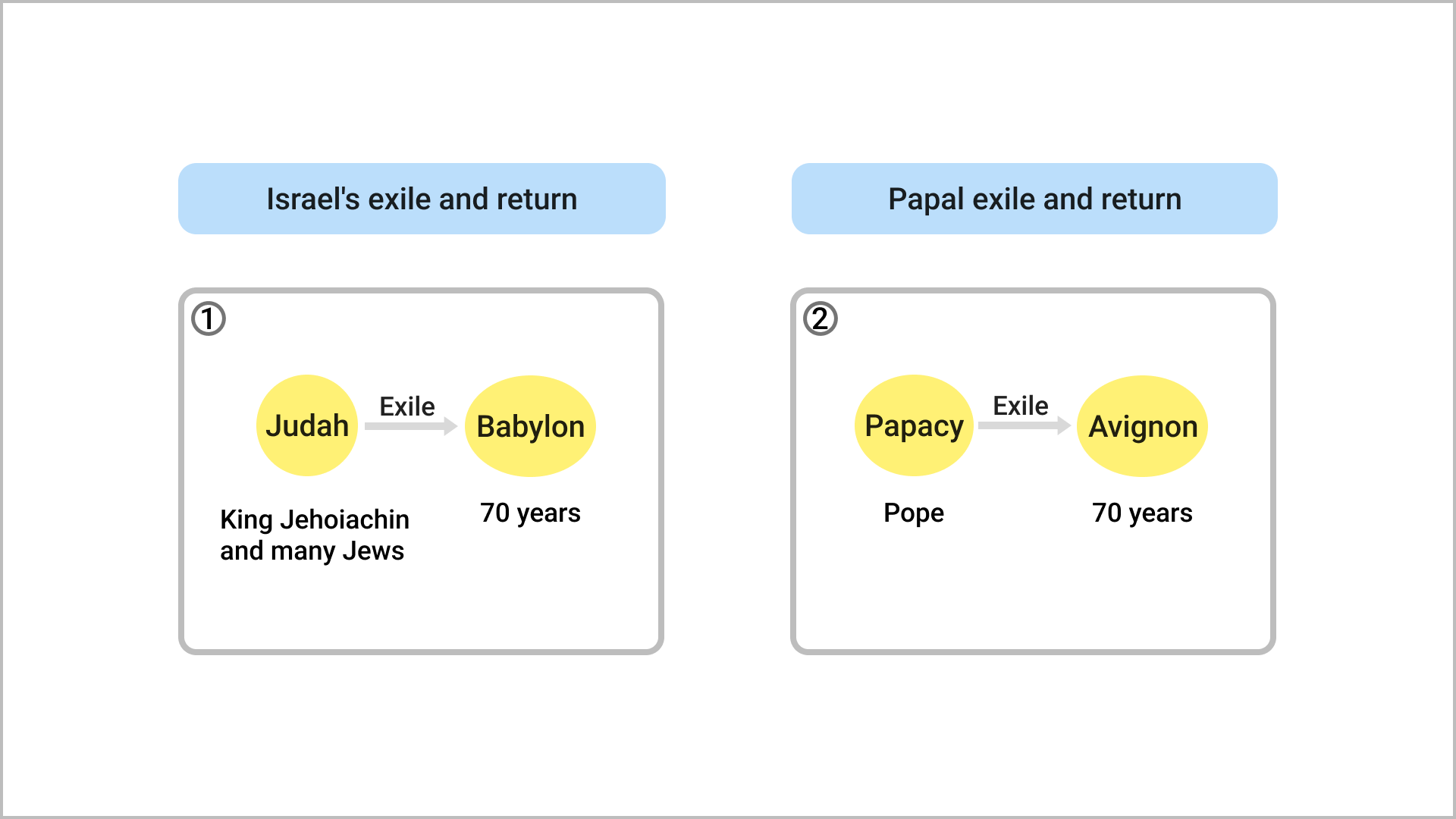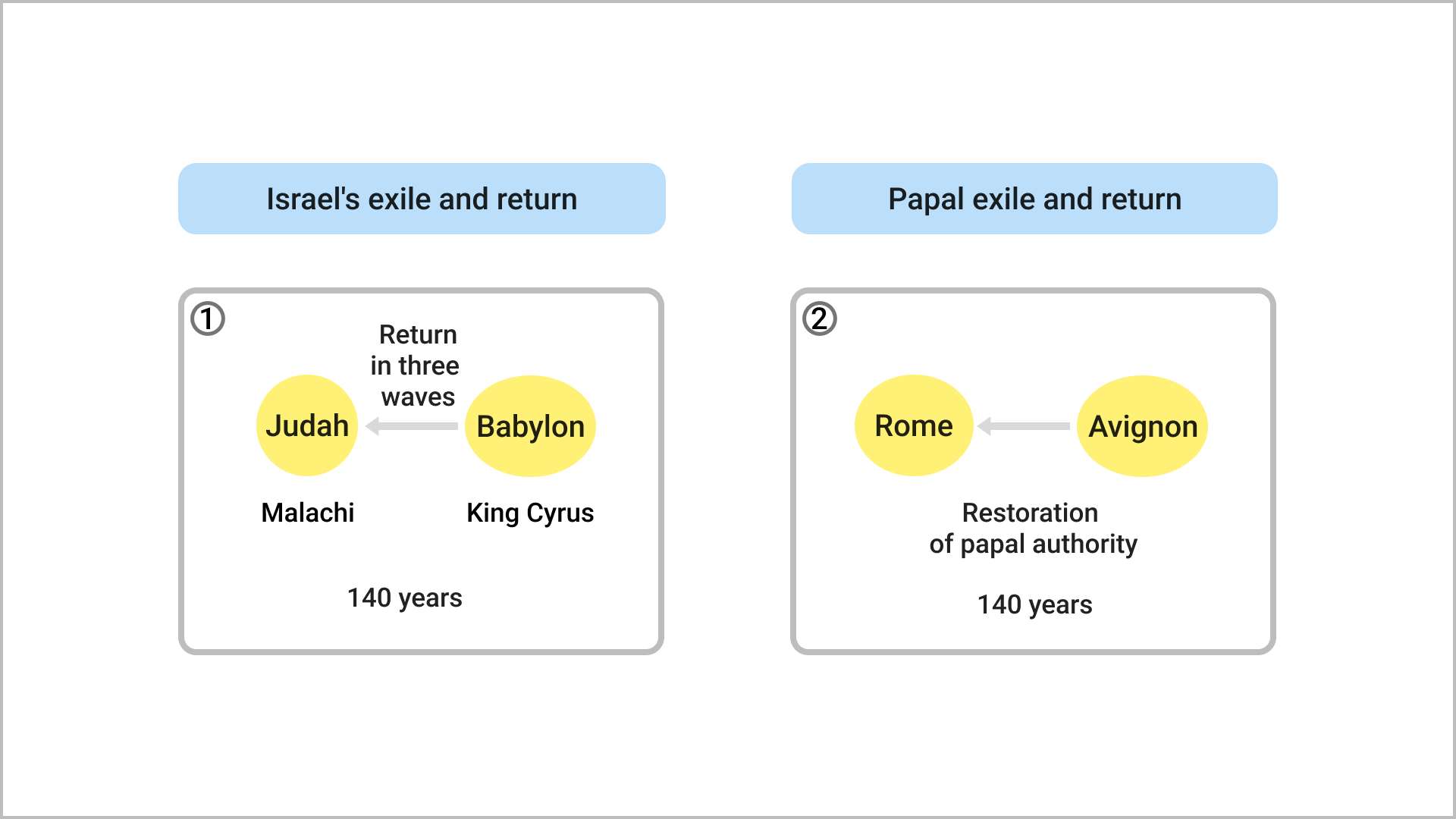제5절 유대민족 포로 및 귀환시대와 교황 포로 및 귀환시대
유대민족이 불신으로 돌아가서 회개하지 않음으로 인하여 성전이상(聖殿理想)을 복귀할 수 없게 되었기 때문에, 하나님은 다시 이 뜻을 이루시기 위하여 마치 아브라함의 헌제(獻祭) 실수를 탕감복귀케 하시려고 이스라엘 민족으로 하여금 사탄세계인 애급(埃及)으로 들어가서 고역(苦役)을 당하게 하셨던 것처럼, 유대민족도 사탄세계인 바빌론으로 포로 되어 가서 고역을 당하게 하셨던 것이다.
By falling into faithlessness without repentance, the people of Israel failed to realize the ideal of God’s nation founded upon the Temple. To make another attempt at fulfilling this Will, God had the people suffer hardships as exiles in Babylon. This was similar to when God had the Israelites suffer as slaves in Egypt to restore through indemnity Abraham’s mistake in the symbolic offering.
이와 마찬가지로 이미 위에서 논한 바와 같이, 하나님이 기독왕국시대(基督王國時代)를 세우신 것은 교황(敎皇)과 국왕(國王)을 중심하고 ‘재림하실 메시아를 위한 기대’를 조성하여, 그 기대 위에 메시아로 재림(再臨)하시는 ‘만왕의 왕’에게 그 나라와 왕위(王位)를 인계해 드림으로써 메시아 왕국을 건설하기 위함이었다(사 9 : 6, 눅 1 : 33). 그러나 국왕과 그를 ‘실체기대(實體基臺)’의 중심인물로 세우기 위한 영적인 기대를 조성해야 할 교황들이 부패한 가운데서 끝내 회개하지 않았으므로 그들은 ‘재림하실 메시아를 위한 기대’를 조성하지 못하였다. 이에 하나님께서는 이 기대를 복귀하기 위한 새로운 섭리를 하시기 위하여 교황으로 하여금 포로가 되어 고역을 당하게 하셨던 것이다.
In the period of the Christian empire, God worked through the pope and the emperor to establish a kingdom prepared for Christ at his Second Coming. God’s intention was that ultimately they would bequeath the empire and the throne to the Messiah when he would come as the King of Kings and build God’s kingdom (Isa. 9:6); (Luke 1:33) upon that foundation. Yet the emperors and popes became corrupt and did not repent. The popes did not lay the spiritual foundation upon which the emperors could stand as the central figures for the foundation of substance. Therefore, the foundation for the Second Advent of Christ was not established. To begin a new dispensation to restore this foundation, God allowed the popes to be taken into exile and suffer captivity.
전에 여호야김왕을 비롯하여 다니엘과 기타 왕족들, 그리고 정부 대신(大臣)들과 관리(官吏)와 공장(工匠) 등 많은 유대인들이 바빌로니아의 왕 느부갓네살에게 포로로 잡혀 갔던 70년 기간이 있었고(렘 39 : 1∼10, 왕하 24, 25장), 페르시아가 바빌로니아를 멸하고 고레스왕이 조서(詔書)를 내려 그들을 해방시킨 후 3차에 걸쳐 고향으로 귀환하여 선지자(先知者) 말라기를 중심하고 메시아를 위한 준비를 하는 민족으로 세워질 때까지의 140년 기간이 있었다. 이 시대를 실체적인 동시성으로 탕감복귀하는 교황 포로 및 귀환시대에 있어서도 이와 같은 노정을 걸어야 했었다.
In the earlier parallel period, nearly seventy years elapsed from the time King Nebuchadnezzar of Babylon took into captivity King Jehoiachin and his royal family, as well as prophets including Daniel and Ezekiel, priests, officials, craftsmen and many other Israelites, until the fall of Babylon and their liberation by the royal decree of King Cyrus. (II Kings 24; 25); (II Chron. 36); (Jer. 29:10); (Jer. 39:1-10) It then took another 140 years for the exiles to return to their homeland in three waves, until they fully reformed themselves as a nation united around the Will of God as proclaimed in the messianic prophecies of Malachi. Henceforth, they began to prepare for the coming of the Messiah. In the period of papal exile and return, which was to restore this period through indemnity in the form of substantial parallels, Western Christianity had to walk a similar course.
교황(敎皇)과 승려(僧侶)들은 그들의 부도덕(不道德)으로 말미암아 점차로 국민들의 신망을 잃어버리게 되었고, 그 위에 십자군전쟁(十字軍戰爭)에 패함으로 인하여 교황의 권위는 땅에 떨어지게 되었었다. 한편 십자군전쟁 이후 봉건제도(封建制度)가 몰락되고 근대국가가 성립되자 점차로 왕권(王權)이 신장되면서 교황과 국왕과의 충돌은 격화되었던 것이다. 그리하여 교황 보니파키우스 8세는 불왕(佛王) 필립 4세와 충돌되어 일시 그에게 금고(禁錮)를 당하는 데까지 이르렀던 것이다. 그 후 1대를 지나서 1305년에 교황으로 피선된 클레멘스 5세는 1309년에 교황청(敎皇廳)을 로마로부터 남불(南佛)의 아비뇽으로 옮기었고, 거기에서 70년 간 역대의 교황들은 불왕의 구속을 받으면서 포로와 같은 생활을 하게 되었었다. 그 후 교황 그레고리우스 11세는 1377년 로마로 귀환하였다.
The popes and priests, sunk in immorality, gradually lost the confidence of the people. The authority of the papacy sank even lower due to the repeated defeats of the Crusades. The end of the Crusades saw the gradual collapse of the feudal system in Europe and the emergence of modern nation-states. As the power of secular monarchies grew, the conflict between the popes and the kings escalated. In one such conflict, King Philip IV, “the Fair,” of France imprisoned Pope Boniface VIII for a time. In 1309, Philip forced Pope Clement V to move the papacy from Rome to Avignon in southern France. For seventy years, successive popes lived there subject to the kings of France, until 1377 when Pope Gregory XI returned the papal residence to Rome.

그가 서거(逝去)한 후에 추기경(樞機卿)들은 이태리의 바리의 감독(監督) 울바누스 6세를 교황으로 선출하였다. 그러나 불인(佛人)이 다수였던 추기경들은 오래지 않아 울바누스를 배척하고, 따로이 클레멘스 7세를 교황으로 선출하여 남불 아비뇽에 또 하나의 교황청을 세우게 되었었다. 이 분리는 다음 세기에 이르러 개혁회의(改革會議)에서 해결될 때까지 계속되었다. 즉 1409년에 추기경들은 이태리의 피사에서 회의를 열어 분리되어 온 두 교황을 모두 폐위(廢位)시키고 알렉산더 5세를 정당한 교황으로 임명하였다. 그러나 폐위된 두 교황이 이에 불복(不服)함으로써 일시 3인의 교황이 정립(鼎立)하게 되었었다. 그 후 다시 감독과 대감독(大監督) 외에 신학자(神學者), 왕후(王侯), 사절(使節) 등 많은 참석자로써 콘스탄트대회를 개최하여, 3인의 교황을 일제히 폐위시키고 다시 마루티누스 5세를 교황으로 선출하였다.
After Gregory’s death, the cardinals elected an Italian, the Archbishop of Bari, as Pope Urban VI. However, a group of cardinals, mostly Frenchmen, rejected him, elected another pope, Clement VII, and established a rival papacy in Avignon. The Great Schism continued into the next century. To resolve this impasse, the cardinals from both camps held a council in Pisa, Italy, in 1409, which dismissed both the Roman and Avignon popes and appointed Alexander V as the legitimate pope. The two popes, however, refused to resign, creating for a short time the spectacle of three contending popes. Shortly afterwards, cardinals, bishops, theologians, royalty and their envoys gathered for the General Council of Constance (1414-1417). It dismissed all three popes and elected Martin V as the new pope, effectively ending the Great Schism.
이와 같이 하여 교황 선출의 권한을 추기경들로부터 빼앗아 로마교회의 지상권(至上權)을 주장하던 이 회의에로 옮겼다(1418년). 이 회의는 그 후 스위스의 바젤에서 로마교회 기구를 입헌군주체(立憲君主體)로 할 목적으로 열렸었다. 그러나 교황은 회중(會衆)들의 이러한 주관성을 좋지 않게 생각하고 이 회의에 참석하지 않았을 뿐만 아니라, 그것을 유회(流會)시키려고까지 하였다. 그래도 교황당(敎皇黨) 이외의 의원들은 개회를 강행하였으나 1449년에 저절로 해산되고 말았다. 이와 같이 로마교회 내에 입헌군주체를 수립하려던 계획은 수포로 돌아가고, 1309년 이래 잃어버렸던 교황전정(敎皇專政)의 기능을 회복하였다.
The Council of Constance insisted that the general councils of the Church had supreme authority, greater than that of the pope and with the power to elect or depose him, and directed that subsequent councils be held at regular intervals. Thus, it sought to reorganize the Roman church as a constitutional monarchy. However, in 1431, when delegates gathered for the next council, held in Basel, Switzerland, the pope tried to adjourn the meeting. The delegates refused to leave and carried on in the pope’s absence, but to no effect; in 1449, they finally disbanded. The plan to institutionalize a constitutional monarchy within the Roman church came to naught, and the papacy recovered the authority it had lost in 1309.
14세기의 제회의(諸會議)의 지도자들은 평신도들을 대표로 세우고, 이 회의에 최고의 권한을 부여함으로써 부패한 교황과 승려들을 제거하려 하였었다. 그러나 교황권(敎皇權)은 그들의 유수(幽囚) 전과 같은 입장으로 돌아갔을 뿐 아니라, 위클리프나 후스 같은 개혁정신(改革精神)을 가진 지도자들을 극형에 처하게 되었으므로, 이때부터 프로테스탄트 종교개혁운동(宗敎改革運動)은 싹트기 시작하였던 것이다.
The leaders of the conciliar movement in the fifteenth century had tried to reform the corrupt papacy by setting up a representative council composed of bishops and laymen and giving it supreme authority. Nevertheless, the papacy ended up reasserting its full authority, as it had not enjoyed since before its exile. Furthermore, these councils condemned more fundamental reforms as promoted by John Wycliffe (1330-1384) and Jan Hus (1373-1415), who was personally invited to attend the Council of Constance only to be burned at the stake. At that point, the die was cast for the outbreak of the Protestant Reformation.
이와 같이 교황이 1309년으로부터 70년 간 남불(南佛) 아비뇽에 유수되었다가 3교황으로 분립되었던 노정을 거쳐 다시 로마교회를 중심한 교황전정(敎皇專政)으로 복귀된 후, 1517년에 루터를 중심하고 종교개혁(宗敎改革)이 일어날 때까지의 약 210년 간은, 유대민족이 바빌론에 70년 간 포로 되었다가 3차에 걸쳐 예루살렘으로 귀환하여 말라기를 중심하고 정교(政敎)의 쇄신(刷新)을 일으킬 때까지의 210년 간을 실체적인 동시성으로 탕감복귀(蕩減復歸)하는 기간이었던 것이다.
This period of approximately 210 years ran from 1309, with the papacy’s seventy years of exile in Avignon, through the Great Schism, the conciliar movement and the restoration of papal authority in the Roman church, to the eve of the Protestant Reformation spearheaded by Martin Luther in 1517. Its purpose was to restore through indemnity, in the form of substantial parallels, the 210-year period of Israel’s exile and return – from Israel’s seventy years of exile in Babylon through the stages of the returning to Israel and the rebuilding of the Temple, until the reform of politics and religion under the leadership of Ezra, Nehemiah and the prophet Malachi.\
